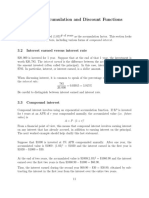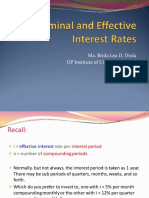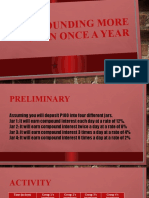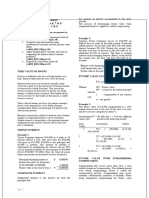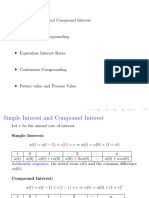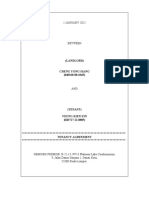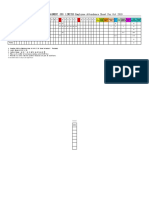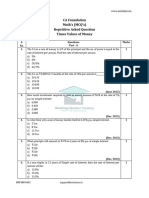Chapter 6 - Time Value of Money - Part 2
Uploaded by
symtgywsq8Chapter 6 - Time Value of Money - Part 2
Uploaded by
symtgywsq8Time Value of Money – Part 2
1-1
5.5 Compounding Interest More Frequently
Than Annually
Semiannual Compounding
◦ Compounding of interest over two periods within
the year
◦ The investment pays half its annual stated interest
rate every six months, rather than making one
payment at the end of the year.
1-2
Example 5.15
Fred Moreno has decided to invest $100 in a savings account paying 8%
annual interest compounded semiannually. If he leaves his money in the
account for 24 months, he will receive 4% interest compounded over four
periods, each of which is six months long. Table 5.3 shows that after 12
months with 8% semiannual compounding, Fred will have $108.16; after 24
months, he will have $116.99.
Table 5.3 Future Value from Investing $100 at 8% Interest Compounded
Semiannually over 24 Months (2 Years)
Beginning Future value at end
Period principal Future value calculation of period
6 months $100.00 $100.00 × (1 + 0.04) = $104.00
12 months 104.00 $104.00 × (1 + 0.04) = $108.16
18 months 108.16 $108.16 × (1 + 0.04) = $112.49
24 months 112.49 $112.49 × (1 + 0.04) = $116.99
1-3
5.5 Compounding Interest More Frequently
Than Annually
Quarterly Compounding
◦ Compounding of interest over four periods within
the year
◦ One-fourth of the stated interest rate is paid four
times a year
1-4
Example 5.16
Fred Moreno has found an institution that will pay him 8% annual interest
compounded quarterly. If he leaves his money in this account for 24 months,
he will receive 2% interest compounded over eight periods, each of which is
three months long. Table 5.4 shows the amount Fred will have at the end of
each period. After 12 months, with 8% quarterly compounding, Fred will have
$108.24; after 24 months, he will have $117.17.
Table 5.4 Future Value from Investing $100 at 8% Interest Compounded
Quarterly over 24 Months (2 Years)
Period Beginning principal Future value calculation Future value at end of period
3 months $100.00 $100.00 × (1 + 0.02) = $102.00
6 months 102.00 $102.00 × (1 + 0.02) = $104.04
9 months 104.04 $104.04 × (1 + 0.02) = $106.12
12 months 106.12 $106.12 × (1 + 0.02) = $108.24
15 months 108.24 $108.24 × (1 + 0.02) = $110.41
18 months 110.41 $110.41 × (1 + 0.02) = $112.62
21 months 112.62 $112.62 × (1 + 0.02) = $114.87
24 months 114.87 $114.87 × (1 + 0.02) = $117.17
1-5
Example 5.16
Table 5.5 compares values for Fred Moreno’s $100 at the end of years 1 and 2,
given annual, semiannual, and quarterly compounding frequency at the 8%
annual rate. The table shows that the more frequently interest compounds,
the greater the amount of money that accumulates. This statement is true
for any interest rate above zero for any time horizon.
Table 5.5 Future Value at the End of Years 1 and 2 from Investing $100
at 8% Interest, Given Various Compounding Periods
1-6
5.5 Compounding Interest More Frequently
Than Annually
A General Equation for Compounding
mn
r
FVn = PV0 1 + (5.9)
m
1-7
Example 5.17
The preceding examples calculated the amount that Fred Moreno would have after
two years if he deposited $100 at 8% interest compounded semiannually or quarterly.
For semiannual compounding, m would equal 2 in Equation 5.9; for quarterly
compounding, m would equal 4. Substituting the appropriate values for semiannual and
quarterly compounding into Equation 5.9, we find that
1. For semiannual compounding:
22
0.08
FV2 = $100 1 + = $100 (1 + 0.04)4 = $116.99
2
2. For quarterly compounding:
42
0.08
FV2 = $100 1 + = $100 (1 + 0.02)8 = $117.17
4
These results agree with the values after two years in Table 5.5. If the interest were
compounded monthly, weekly, or daily, m would equal 12, 52, or 365, respectively.
1-8
Example 5.18
Fred Moreno wished to find the future value of $100 invested at 8% interest compounded both
semiannually and quarterly for two years.
Calculator use If the calculator were used for the semiannual
compounding calculation, the periods per year represents the
compounding periods per year and would be 2, the number of
semiannual periods would be 4, the annual interest rate would
be 8%, and the present value would be -100. The future value
of $116.99 will appear on the calculator display as shown to
the left.
For the quarterly compounding case, the compounding periods per
year would be 4, the number of quarterly periods would be 8, the
annual interest rate would be 8%, and the present value would be -
100. The future value of $117.17 will appear on the calculator
display as shown to the left.
Copyright © 2022 Pearson Education, Ltd.
5.5 Compounding Interest More Frequently
Than Annually
Nominal and Effective Annual Rates of
Interest
◦ Nominal (Stated) Annual Rate
Contractual annual rate of interest charged by a
lender or promised by a borrower
◦ Effective (True) Annual Rate (EAR)
The annual rate of interest actually paid or
m
earned r
EAR = 1 + − 1 (5.11)
m
1-10
Example 5.20
Fred Moreno wishes to find the effective annual rate associated with an 8% nominal annual
rate (r = 0.08) when interest is compounded (1) annually (m = 1), (2) semiannually (m = 2),
and (3) quarterly (m = 4). Substituting these values into Equation 5.11, we get
1. For annual compounding:
1
0.08
EAR = 1 + − 1 = (1 + 0.08) − 1 = 1 + 0.08 − 1 = 0.08 = 8%
1
1
2. For semiannual compounding:
2
0.08
EAR = 1 + − 1 = (1 + 0.04) − 1 = 1.0816 − 1 = 0.0816 = 8.16%
2
2
3. For quarterly compounding:
4
0.08
EAR = 1 + − 1 = (1 + 0.02) − 1 = 1.0824 − 1 = 0.0824 = 8.24%
4
4
1-11
5.5 Compounding Interest More Frequently
Than Annually
Nominal and Effective Annual Rates of
Interest
◦ Annual Percentage Rate (APR)
The nominal annual rate of interest, found by
multiplying the periodic rate by the number of
periods in one year, that must be disclosed to
consumers on credit cards and loans as a result
of “truth-in-lending laws.”
◦ Annual Percentage Yield (APY)
The effective annual rate of interest that must be
disclosed to consumers by banks on their
savings products as a result of “truth-in-savings
laws.” 1-12
End of Week 8
McGraw-Hill/Irwin 1-13
You might also like
- Mathematics of Finance: Faculty of Business Studies (FBS) Bangladesh University of Professionals (BUP)No ratings yetMathematics of Finance: Faculty of Business Studies (FBS) Bangladesh University of Professionals (BUP)52 pages
- Time Value of Money Compounding Technique and Discounting TechniqueNo ratings yetTime Value of Money Compounding Technique and Discounting Technique14 pages
- 3 More On Accumulation and Discount FunctionsNo ratings yet3 More On Accumulation and Discount Functions9 pages
- Compound Interest, Future Value, and Present ValueNo ratings yetCompound Interest, Future Value, and Present Value43 pages
- (Wiley Finance) Amir Sadr - Ma - An Introduction-Wiley (2022) 38No ratings yet(Wiley Finance) Amir Sadr - Ma - An Introduction-Wiley (2022) 381 page
- Welcome To Unit 6: Compound Interest, Future and Present ValuesNo ratings yetWelcome To Unit 6: Compound Interest, Future and Present Values22 pages
- CE22 - 06 - Nominal Effective Interest RateNo ratings yetCE22 - 06 - Nominal Effective Interest Rate42 pages
- Lesson 26 Compounding More Than Once A YearNo ratings yetLesson 26 Compounding More Than Once A Year23 pages
- 7 - Compound Interest and Present Value (1)No ratings yet7 - Compound Interest and Present Value (1)18 pages
- Winter Semester 2023-24 - MGT2006 - TH - AP2023246000029 - 2024-01-20 - Reference-Material-INo ratings yetWinter Semester 2023-24 - MGT2006 - TH - AP2023246000029 - 2024-01-20 - Reference-Material-I24 pages
- Compound Interest: Simple Interest vs. Compound Interest Formula Sample Problems100% (1)Compound Interest: Simple Interest vs. Compound Interest Formula Sample Problems46 pages
- Compound Interest: I. Definitions and FormulaNo ratings yetCompound Interest: I. Definitions and Formula6 pages
- Mathematics of Finance: Md. Aktar Kamal Lecturer Department of Management Bangladesh University of Professionals (BUPNo ratings yetMathematics of Finance: Md. Aktar Kamal Lecturer Department of Management Bangladesh University of Professionals (BUP14 pages
- Mathematics of Finance: Section 2 Compound and Continuous Compound InterestNo ratings yetMathematics of Finance: Section 2 Compound and Continuous Compound Interest28 pages
- Personal Money Management Made Simple with MS Excel: How to save, invest and borrow wiselyFrom EverandPersonal Money Management Made Simple with MS Excel: How to save, invest and borrow wiselyNo ratings yet
- TAIHUA SHIP MANAGEMENT (BD) LIMITED Employee Attendance Sheet For Oct 2019No ratings yetTAIHUA SHIP MANAGEMENT (BD) LIMITED Employee Attendance Sheet For Oct 20192 pages
- Times Values of Money MCQ's Live Class 15-04-2023No ratings yetTimes Values of Money MCQ's Live Class 15-04-202335 pages
- Module 4 Assessment Task - Employee BenefitsNo ratings yetModule 4 Assessment Task - Employee Benefits2 pages
- Lecture 2 - Consolidation - Subsequent to Date ProblemsNo ratings yetLecture 2 - Consolidation - Subsequent to Date Problems3 pages
- Finding Time and Rate For Compound InterestNo ratings yetFinding Time and Rate For Compound Interest11 pages





